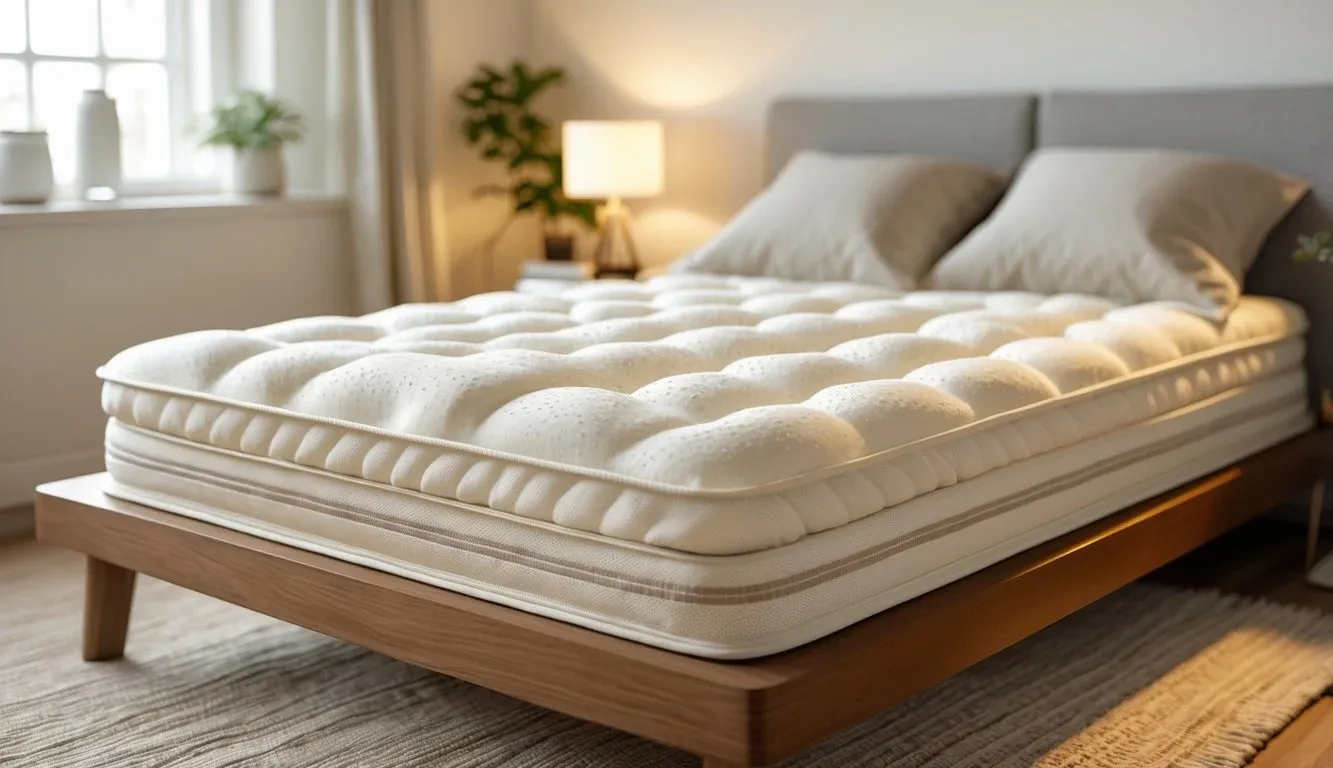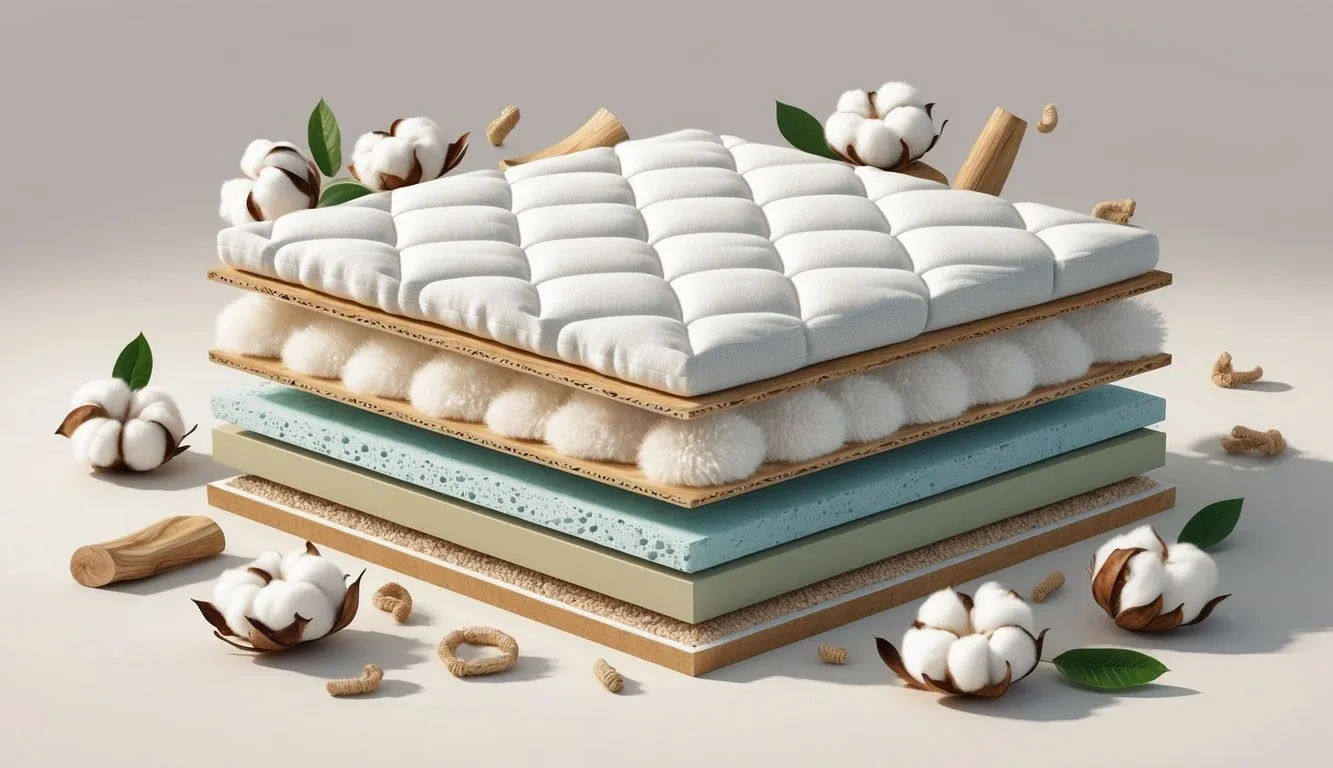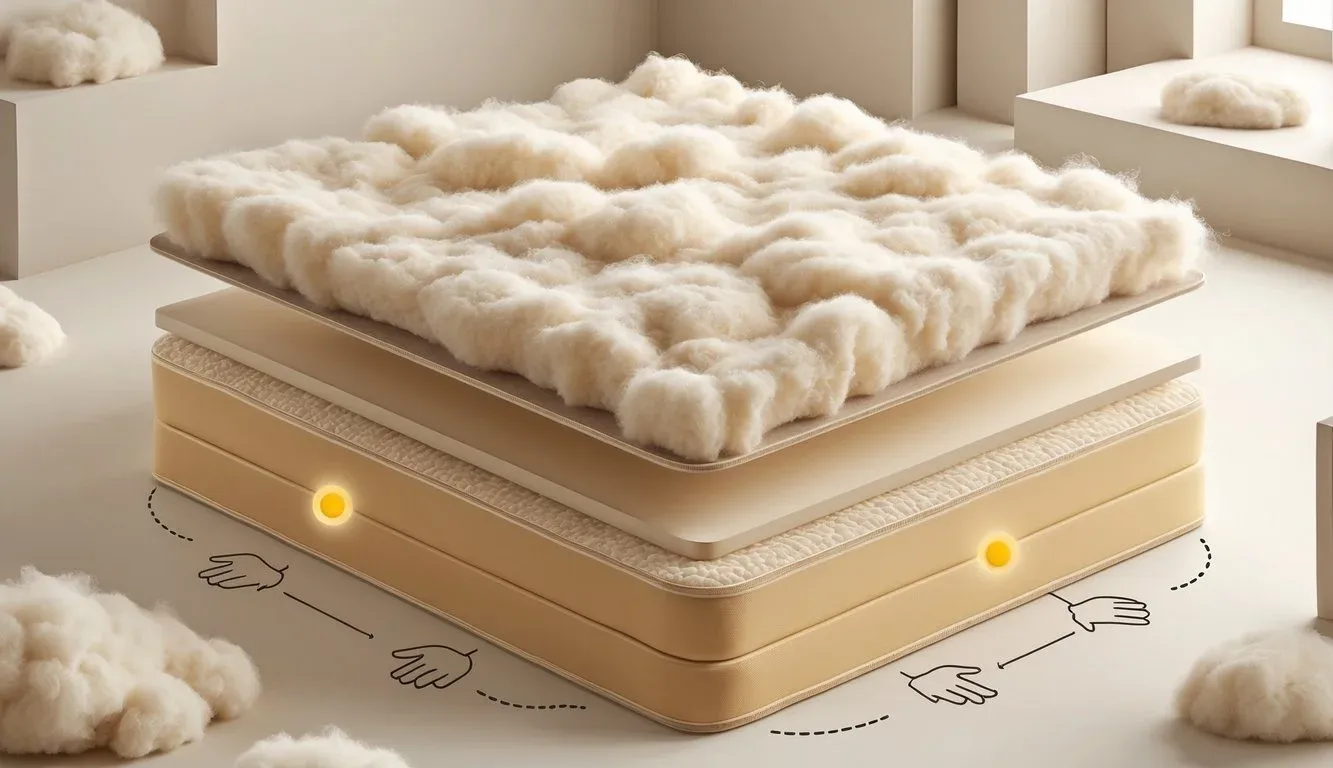Most people want a comfortable and supportive mattress to help them sleep better at night. The Kapok mattress, with its natural materials and unique feel, has gained attention from shoppers who care about sleep quality and health. This review covers what makes the Kapok mattress different, how it feels to sleep on, and if it is worth the price.

People who worry about chemicals or who want eco-friendly products may find the Kapok mattress appealing. Even those who have back pain often wonder if this mattress can give them the support they need. This review will give clear information to help readers decide if the Kapok mattress is right for them.
Kapok Mattress Review – An Overview

A kapok mattress uses kapok fiber from the seed pods of the kapok tree. These mattresses are often marketed as an alternative to latex and foam options and appeal to those wanting a bed made from more natural materials.
Kapok Fiber and Its Properties
Kapok fiber is a soft, silky material taken from the seed pods of the kapok tree (Ceiba pentandra). The fibers are light and fluffy. They feel similar to down and are often described as airy or buoyant.
Kapok fibers are naturally water-resistant, so they do not absorb moisture easily. They have a hollow core, which helps make the material breathable and lightweight.
Features of kapok fiber:
- All-natural, plant-based material
- Hypoallergenic for many people
- Good airflow due to the hollow fiber structure
- Resistant to mold and mildew growth
These qualities make kapok fiber useful in pillows and mattresses. However, kapok can be more delicate compared to other fibers, so it compresses over time and may need regular fluffing.
Differences from Latex and Foam Mattresses
Kapok mattresses stand apart from latex and foam mattresses mainly by their filling material. While kapok uses a plant-based fiber, latex mattresses are made from rubber sap, and foam mattresses use synthetic or polyurethane foams.
Comparison Table:
| Feature | Kapok Mattress | Latex Mattress | Foam Mattress |
|---|---|---|---|
| Main Material | Kapok fiber | Natural or synthetic latex | Polyurethane/Mem. foam |
| Breathability | Good | Good | Varies (can trap heat) |
| Synthetic Content | None (usually) | Varies | Usually high |
| Feel | Soft, plush | Resilient, bouncy | Contouring, can feel dense |
| Eco-friendliness | High | Medium to high (if natural) | Low |
Latex and foam tend to return their shape better and are usually more supportive. In contrast, kapok mattresses feel softer and lighter, with more of a pillow-like loft. Some users prefer kapok for its completely plant-based filling and softness.
Kapok Filling Composition
A kapok mattress typically uses kapok fiber as the primary filling. Sometimes, other natural materials like cotton or wool are blended in for added structure and support. It’s rare for these mattresses to be made entirely from kapok because the fiber is very light and airy.
Typical composition might include:
- 70-90% kapok fiber
- 10-30% cotton or wool (for shape and durability)
This mix helps the mattress keep its loft while providing some firmness. Covers are often made from organic cotton, making the mattress more breathable and 100% free from synthetic materials.
The all-natural content of kapok mattresses appeals to people who want an eco-friendly and hypoallergenic sleep surface. However, since kapok is less dense, the mattress might not suit those needing firm or extra-supportive beds. Regular tossing or fluffing helps these mattresses keep their shape over time.
Construction and Materials

The Kapok mattress is built with a focus on natural bedding materials and careful craftsmanship. It combines an organic cotton cover, layers of natural latex, and organic wool to support comfort, breathability, and durability.
Organic Cotton Cover Overview
The Kapok mattress uses an organic cotton cover that is certified free from synthetic chemicals. This cotton cover feels soft to the touch and is gentle against the skin. It helps regulate temperature by letting air move freely through the surface.
Organic cotton gives this mattress cover a breathable and moisture-wicking quality. It’s strong enough to protect the mattress core but lightweight for easy handling. This cover is also hypoallergenic, making it suitable for those with allergies or sensitive skin.
Quality stitching along the seams reduces wear and tear. The use of organic cotton minimizes chemical exposure and supports eco-friendly farming.
Natural Latex Layers
Beneath the cover, the mattress features layers of natural latex. These latex layers provide important support and pressure relief. Latex is a durable, springy material that helps keep the mattress in shape.
Natural latex is made from rubber tree sap and is processed without harsh chemicals. This makes it a good choice for people who want natural bedding. The latex layers can help with motion isolation, meaning less movement from a partner is felt.
A table of benefits:
| Feature | Benefit |
|---|---|
| Responsiveness | Quick bounce-back |
| Durability | Long-lasting support |
| Breathability | Promotes airflow |
Latex also resists dust mites and helps prevent the growth of mold.
Use of Organic Wool
Organic wool plays a key role in the Kapok mattress. It is stitched below the cotton cover and acts as both a flame barrier and a temperature regulator. Wool keeps sleepers cool in summer and warm in winter by controlling moisture and heat.
The organic wool in this mattress is sourced without pesticides or artificial treatments. Wool fibers naturally resist bacteria and dust mites. This makes the mattress safer and more comfortable for most users.
Wool also adds a soft, plush layer that increases comfort without the need for synthetic fillers. Its use supports sustainable farming and animal care standards.
Comfort and Firmness

Kapok mattresses use natural fibers that provide a balance of gentle softness and steady support. The mix of kapok fill and other materials affects how the bed feels and how well it helps with body alignment.
Comfort Level and Feel
Kapok mattresses are known for their plush surface and medium firmness. The outer layer, often made from organic cotton, works with the kapok fibers to give a soft, cushiony touch. When lying down, people may notice a gentle sinking feeling, but the mattress does not let them sink too much.
Unlike foam mattresses, kapok does not trap as much heat. Many users find the bed cooler during the night. People with sensitive skin may appreciate that kapok is hypoallergenic and smooth.
Those who prefer a firmer bed should know that kapok mattresses usually have a more flexible feel. The mattress recovers its shape quickly after shifting or getting up. This can help people move around without feeling stuck.
Support for Neck and Spine
Support is often a concern, especially for those with neck pain or spinal issues. Kapok mattresses offer moderate support for the back, neck, and joints. While not as firm as a coil or latex mattress, the kapok fill adapts to the curve of the spine.
People who use kapok pillows may see extra benefits, as the pillow and mattress together promote natural alignment. The mattress helps keep the hips and shoulders level, which can reduce pressure on the neck.
Side and back sleepers often report the best experience with kapok for spinal support. Stomach sleepers may want extra firmness or support from another layer. For some, the gentle firmness of kapok helps keep the head and neck in a neutral position, which helps prevent stiffness in the morning.
Health, Safety, and Certifications

Health and safety are top concerns when picking a mattress. The presence of flame retardants, off-gassing, and specific organic certifications directly impacts air quality and user well-being.
Flame Retardants and Off-Gassing
Kapok mattresses often avoid chemical flame retardants, instead using materials like wool for natural fire resistance. This reduces exposure to harsh chemicals, which some studies link to health issues.
Off-gassing means the release of odors and chemicals after unboxing a mattress. Kapok mattresses made from natural and organic materials generally have low off-gassing. Many users report only a mild, short-lived scent. This is different from standard foam mattresses that may smell stronger for longer due to petroleum-based ingredients.
Below is a table comparing flame retardant use and off-gassing between kapok and traditional mattresses:
| Mattress Type | Flame Retardants | Off-Gassing Level |
|---|---|---|
| Kapok | Mostly natural (wool) | Low |
| Memory Foam | Synthetic chemicals often | Moderate to high |
Organic Certification Standards
Many kapok mattresses are labeled as organic, but it is important to check for certifications. The GOTS (Global Organic Textile Standard) certification is a leading sign the mattress uses verified organic materials and meets strict health criteria.
Certified organic mattresses must avoid most synthetic chemicals and use textiles like organic cotton or wool. GOTS-certified mattresses often do not use chemical flame retardants, further reducing chemical exposure.
Look for clear labels such as GOTS Certified when shopping for a kapok mattress. Double-check that the certification covers the entire mattress and not just the outer fabric. Third-party certifications help ensure the mattress meets the highest standards for safety and environmental impact.
Performance and Durability

Kapok mattresses are known for staying comfortable over time while providing support for different sleep styles. Their natural materials help the mattress resist sagging and wear from regular use.
Longevity and Lifespan
A kapok mattress is designed to last several years, sometimes up to 8–10 years with regular care. The kapok fibers inside the mattress stay fluffy and supportive, helping the mattress keep its shape longer than many traditional foam mattresses. For people searching for the best organic mattress, longevity is an important factor.
Many kapok mattresses also use certified organic cotton covers and natural latex, making them more durable than some all-foam or spring models. Unlike some materials that compress quickly, kapok filling offers slow, even wear over time. This means fewer dips and lumps, which can be a major issue with lower-quality mattresses. The durability depends on usage and body weight—heavier sleepers may see a faster breakdown in support.
Maintenance and Care
Taking care of a kapok mattress is simple but important for lasting performance. Regularly rotating the mattress, about every 3–6 months, helps spread out pressure and keeps the filling evenly distributed. Using a washable mattress protector helps guard against stains and moisture, which can harm the natural fibers.
Kapok is naturally resistant to dust mites and mold, making it a cleaner choice than some synthetic options. If the mattress has a removable cover, washing it gently in cold water will keep it fresh. For spot cleaning, use mild soap and water to avoid damaging the organic materials. Good airflow—by letting the mattress “breathe”—also prevents odors and moisture buildup. Proper care means the kapok mattress can remain comfortable and hygienic for years.
Comparisons with Other Mattress Types

Kapok mattresses are often compared to latex, foam, and organic mattresses because of their focus on comfort and natural materials. Each type has different benefits related to support, breathability, and eco-friendliness.
Kapok Versus Latex and Foam Mattresses
Latex mattresses are known for their strong support and long lifespan. They use either natural or synthetic latex. Most latex mattresses resist dust mites and mold, which is good for people with allergies. However, they can feel firm and heavy, and they usually cost more.
Foam mattresses, especially memory foam, shape themselves to the body and help reduce movement. Many foam mattresses can feel warm because they trap heat. Some contain chemicals that may cause an odor when new.
Kapok mattresses have a soft and fluffy feel from the kapok fibers. They use plant-based materials, so they may be a greener choice than basic foam. Kapok is also lightweight and allows air to flow, which can help the sleeper stay cool. Kapok mattresses do not contour as much as memory foam but can offer gentle, breathable comfort.
| Feature | Kapok Mattress | Latex Mattress | Foam Mattress |
|---|---|---|---|
| Main Material | Kapok Fiber | Natural/Synthetic | Polyurethane |
| Feel | Soft, Fluffy | Firm, Responsive | Contouring, Plush |
| Breathability | High | High | Low |
| Eco-Friendliness | High | Varies | Low |
| Weight | Light | Heavy | Moderate |
Kapok Mattress vs Organic Mattress
Organic mattresses are made from certified organic materials, like organic latex, cotton, or wool. They avoid chemicals and synthetic materials and may cost more because of strict standards. Many organic mattresses have strong support and are marketed to buyers who want a “cleaner” sleep surface.
Kapok mattresses use natural fibers but are not always fully organic unless certified. The kapok seed pod filling is untreated and plant-based, reducing chemical use. However, some kapok mattresses might not have organic covers or backing layers.
Both types avoid common chemicals found in standard foam. Here’s a quick look:
- Kapok Mattress
- Made from natural kapok fiber
- Might use non-organic outer fabric
- Lightweight and soft
- Organic Mattress
- Uses organic latex, cotton, or wool
- Often meets third-party certification standards
- Heavier and firmer
Shoppers looking for the most natural option should check certification labels and materials before buying.
Frequently Asked Questions

Kapok mattresses offer unique features such as natural fibers and hypoallergenic properties. Buyers often want details about durability, care, and the difference between mattress types and toppers. Comparing kapok mattresses from different regions also helps in making a choice.
What are the benefits of using a kapok mattress?
Kapok fiber is soft, supportive, and comes from a natural source. It is hypoallergenic for most people and does not trap heat as much as some synthetic materials. Many people also find kapok mattresses to be lightweight and breathable.
How does the durability of a kapok mattress compare to traditional mattresses?
Kapok mattresses last about as long as many traditional cotton or foam mattresses, often between five to ten years with regular use. They are less likely to sag compared to some foam mattresses. However, their lifespan also depends on how often they are used and how well they are maintained.
What are the cleaning and maintenance requirements for a kapok mattress?
Kapok mattresses should not be washed in a machine or soaked with water. It is best to use a mattress cover and spot clean with a damp cloth. Regular airing out in the sun helps keep it fresh and can prevent mold growth.
Can a kapok mattress topper enhance comfort and how does it differ from the full mattress?
A kapok mattress topper can add extra softness or cushioning to a firmer mattress. It is lighter and usually thinner than a full kapok mattress. The topper is designed to go on top of another mattress, not serve as the main sleeping surface on its own.
What should consumers look for when reading kapok mattress reviews?
Consumers should check for comments about firmness, comfort, and whether the mattress holds its shape over time. Look for opinions on breathability, odor, and whether the mattress stays cool during sleep. Reviews about customer service and delivery can also be helpful.
How do Thai kapok mattresses differ from other kapok mattress varieties?
Thai kapok mattresses are often firmer and packed more tightly with kapok fibers than some other types. They are usually thinner and may be used as floor mattresses or foldable mats. Other kapok mattresses might be thicker, softer, and more similar in shape to standard western mattresses.